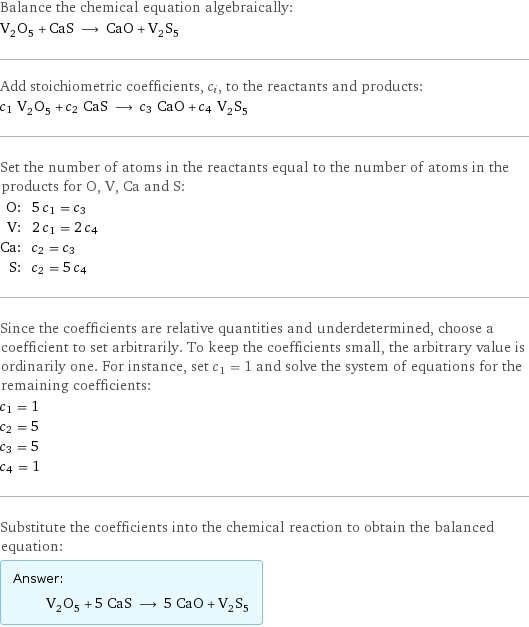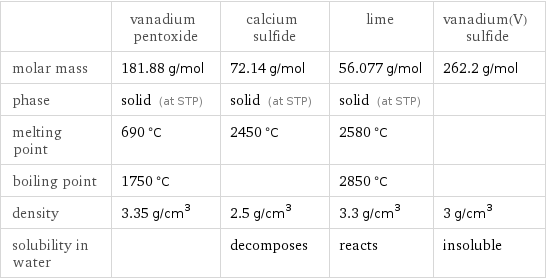Input interpretation

V_2O_5 vanadium pentoxide + CaS calcium sulfide ⟶ CaO lime + V_2S_5 vanadium(V) sulfide
Balanced equation

Balance the chemical equation algebraically: V_2O_5 + CaS ⟶ CaO + V_2S_5 Add stoichiometric coefficients, c_i, to the reactants and products: c_1 V_2O_5 + c_2 CaS ⟶ c_3 CaO + c_4 V_2S_5 Set the number of atoms in the reactants equal to the number of atoms in the products for O, V, Ca and S: O: | 5 c_1 = c_3 V: | 2 c_1 = 2 c_4 Ca: | c_2 = c_3 S: | c_2 = 5 c_4 Since the coefficients are relative quantities and underdetermined, choose a coefficient to set arbitrarily. To keep the coefficients small, the arbitrary value is ordinarily one. For instance, set c_1 = 1 and solve the system of equations for the remaining coefficients: c_1 = 1 c_2 = 5 c_3 = 5 c_4 = 1 Substitute the coefficients into the chemical reaction to obtain the balanced equation: Answer: | | V_2O_5 + 5 CaS ⟶ 5 CaO + V_2S_5
Structures

+ ⟶ +
Names

vanadium pentoxide + calcium sulfide ⟶ lime + vanadium(V) sulfide
Equilibrium constant
![Construct the equilibrium constant, K, expression for: V_2O_5 + CaS ⟶ CaO + V_2S_5 Plan: • Balance the chemical equation. • Determine the stoichiometric numbers. • Assemble the activity expression for each chemical species. • Use the activity expressions to build the equilibrium constant expression. Write the balanced chemical equation: V_2O_5 + 5 CaS ⟶ 5 CaO + V_2S_5 Assign stoichiometric numbers, ν_i, using the stoichiometric coefficients, c_i, from the balanced chemical equation in the following manner: ν_i = -c_i for reactants and ν_i = c_i for products: chemical species | c_i | ν_i V_2O_5 | 1 | -1 CaS | 5 | -5 CaO | 5 | 5 V_2S_5 | 1 | 1 Assemble the activity expressions accounting for the state of matter and ν_i: chemical species | c_i | ν_i | activity expression V_2O_5 | 1 | -1 | ([V2O5])^(-1) CaS | 5 | -5 | ([CaS])^(-5) CaO | 5 | 5 | ([CaO])^5 V_2S_5 | 1 | 1 | [V2S5] The equilibrium constant symbol in the concentration basis is: K_c Mulitply the activity expressions to arrive at the K_c expression: Answer: | | K_c = ([V2O5])^(-1) ([CaS])^(-5) ([CaO])^5 [V2S5] = (([CaO])^5 [V2S5])/([V2O5] ([CaS])^5)](../image_source/640f18f80277984d6f6acb6ed141b81f.png)
Construct the equilibrium constant, K, expression for: V_2O_5 + CaS ⟶ CaO + V_2S_5 Plan: • Balance the chemical equation. • Determine the stoichiometric numbers. • Assemble the activity expression for each chemical species. • Use the activity expressions to build the equilibrium constant expression. Write the balanced chemical equation: V_2O_5 + 5 CaS ⟶ 5 CaO + V_2S_5 Assign stoichiometric numbers, ν_i, using the stoichiometric coefficients, c_i, from the balanced chemical equation in the following manner: ν_i = -c_i for reactants and ν_i = c_i for products: chemical species | c_i | ν_i V_2O_5 | 1 | -1 CaS | 5 | -5 CaO | 5 | 5 V_2S_5 | 1 | 1 Assemble the activity expressions accounting for the state of matter and ν_i: chemical species | c_i | ν_i | activity expression V_2O_5 | 1 | -1 | ([V2O5])^(-1) CaS | 5 | -5 | ([CaS])^(-5) CaO | 5 | 5 | ([CaO])^5 V_2S_5 | 1 | 1 | [V2S5] The equilibrium constant symbol in the concentration basis is: K_c Mulitply the activity expressions to arrive at the K_c expression: Answer: | | K_c = ([V2O5])^(-1) ([CaS])^(-5) ([CaO])^5 [V2S5] = (([CaO])^5 [V2S5])/([V2O5] ([CaS])^5)
Rate of reaction
![Construct the rate of reaction expression for: V_2O_5 + CaS ⟶ CaO + V_2S_5 Plan: • Balance the chemical equation. • Determine the stoichiometric numbers. • Assemble the rate term for each chemical species. • Write the rate of reaction expression. Write the balanced chemical equation: V_2O_5 + 5 CaS ⟶ 5 CaO + V_2S_5 Assign stoichiometric numbers, ν_i, using the stoichiometric coefficients, c_i, from the balanced chemical equation in the following manner: ν_i = -c_i for reactants and ν_i = c_i for products: chemical species | c_i | ν_i V_2O_5 | 1 | -1 CaS | 5 | -5 CaO | 5 | 5 V_2S_5 | 1 | 1 The rate term for each chemical species, B_i, is 1/ν_i(Δ[B_i])/(Δt) where [B_i] is the amount concentration and t is time: chemical species | c_i | ν_i | rate term V_2O_5 | 1 | -1 | -(Δ[V2O5])/(Δt) CaS | 5 | -5 | -1/5 (Δ[CaS])/(Δt) CaO | 5 | 5 | 1/5 (Δ[CaO])/(Δt) V_2S_5 | 1 | 1 | (Δ[V2S5])/(Δt) (for infinitesimal rate of change, replace Δ with d) Set the rate terms equal to each other to arrive at the rate expression: Answer: | | rate = -(Δ[V2O5])/(Δt) = -1/5 (Δ[CaS])/(Δt) = 1/5 (Δ[CaO])/(Δt) = (Δ[V2S5])/(Δt) (assuming constant volume and no accumulation of intermediates or side products)](../image_source/bbe43a679bb715c6d49c7481364a1433.png)
Construct the rate of reaction expression for: V_2O_5 + CaS ⟶ CaO + V_2S_5 Plan: • Balance the chemical equation. • Determine the stoichiometric numbers. • Assemble the rate term for each chemical species. • Write the rate of reaction expression. Write the balanced chemical equation: V_2O_5 + 5 CaS ⟶ 5 CaO + V_2S_5 Assign stoichiometric numbers, ν_i, using the stoichiometric coefficients, c_i, from the balanced chemical equation in the following manner: ν_i = -c_i for reactants and ν_i = c_i for products: chemical species | c_i | ν_i V_2O_5 | 1 | -1 CaS | 5 | -5 CaO | 5 | 5 V_2S_5 | 1 | 1 The rate term for each chemical species, B_i, is 1/ν_i(Δ[B_i])/(Δt) where [B_i] is the amount concentration and t is time: chemical species | c_i | ν_i | rate term V_2O_5 | 1 | -1 | -(Δ[V2O5])/(Δt) CaS | 5 | -5 | -1/5 (Δ[CaS])/(Δt) CaO | 5 | 5 | 1/5 (Δ[CaO])/(Δt) V_2S_5 | 1 | 1 | (Δ[V2S5])/(Δt) (for infinitesimal rate of change, replace Δ with d) Set the rate terms equal to each other to arrive at the rate expression: Answer: | | rate = -(Δ[V2O5])/(Δt) = -1/5 (Δ[CaS])/(Δt) = 1/5 (Δ[CaO])/(Δt) = (Δ[V2S5])/(Δt) (assuming constant volume and no accumulation of intermediates or side products)
Chemical names and formulas

| vanadium pentoxide | calcium sulfide | lime | vanadium(V) sulfide formula | V_2O_5 | CaS | CaO | V_2S_5 Hill formula | O_5V_2 | CaS | CaO | S_5V_2 name | vanadium pentoxide | calcium sulfide | lime | vanadium(V) sulfide IUPAC name | | thioxocalcium | |
Substance properties

| vanadium pentoxide | calcium sulfide | lime | vanadium(V) sulfide molar mass | 181.88 g/mol | 72.14 g/mol | 56.077 g/mol | 262.2 g/mol phase | solid (at STP) | solid (at STP) | solid (at STP) | melting point | 690 °C | 2450 °C | 2580 °C | boiling point | 1750 °C | | 2850 °C | density | 3.35 g/cm^3 | 2.5 g/cm^3 | 3.3 g/cm^3 | 3 g/cm^3 solubility in water | | decomposes | reacts | insoluble
Units
